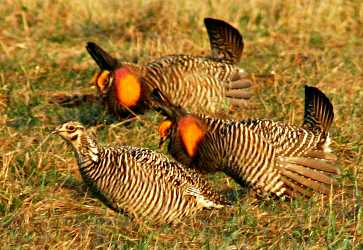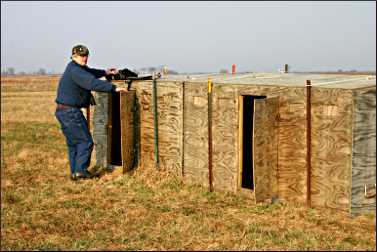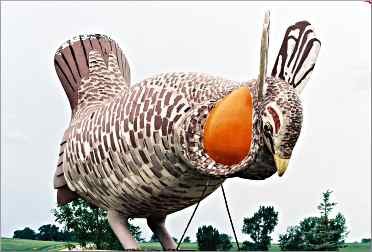Playing the field in Wisconsin
In April, the kooky courtship of prairie chickens brings out the bird watchers.

© Beth Gauper
It's a cold dawn on a Wisconsin marsh, but to a bunch of prairie chickens, it's a hot Saturday night on the town.
They've come to see and be seen, and hormones are in charge. It's serious business, perpetuating a dwindling species.
But to humans watching from a blind, it's high comedy. Whenever a girl chicken is nearby, the boys inflate neon-orange sacs under their throats, drum their feet and start scurrying around like, well, chickens with their heads cut off.
And when a male steps into another's territory, his rival runs up, stares him down and leaps into the air, the bird version of head-butting.
At first, it seems all show, no go. But then we see a male bow, and a female shake ruffled feathers. We've barely seen it, but we know the deed is done.
"Oh, good, I was getting worried," said Marta Anderson of Madison, my seatmate in the blind.
Every April, hundreds of people get up before dawn and head for the mating grounds in central Wisconsin and northwest Minnesota, where the last populations of prairie chickens live.
The once-numerous chickens have been squeezed by agriculture; in Wisconsin, 1,200 of them live in a pocket of marshy sand plains that farmers didn't want.
"It's surrogate grassland, but it's the best we can do," says Sharon Schwab, conservation coordinator of the Golden Sands conservation council in Stevens Point. "The density is as great here as it ever was, but they used to be everywhere."
Eleven months of the year, the prairie chicken is a fairly unremarkable bird. But in spring, their unusual courtship rituals bring onlookers from miles around.
Golden Sands once held a prairie chicken festival in April, to provide blinds but also to drum up interest in the birds and support for efforts to increase their habitat.
One April, I was one of 37 people who showed up at 4:15 a.m. on a Sunday to watch the birds at Buena Vista Marsh, south of Stevens Point. We had to be in place well before the birds arrived, Schwab explained, because the hens might decide not to mate if they were to see us.
Our flashlights barely made a dent in the darkness as my group of four followed volunteer Gina-Marie Jrarek to our blind, a low plywood box on the edge of a clearing.

© Beth Gauper
"Yesterday, this blind had 22 hens, which is more than I've ever seen in five years," Jrarek said. "There were lots of copulations. If you don't watch closely, you might miss it; it doesn't take the males long."
She told us to watch for their "nuptial bow."
By 5:30 a.m., the moon was fading away and the brush was coming alive. Mist rose from the spongy grass. We heard humming, a whir of wings and a high-pitched cackling, like a hyena. But no prairie chickens.
Then the males arrived, taking up positions as close to the center of the clearing as they could get. Any bird that encroached got the rush and stare-down.
It always looked as if it would end in bloodshed, but the aggressor invariably turned away and left in a huff — which showed us why a brief altercation is called "a flap."
When the hens arrived, we expected the boys to go nuts, and they did step it up, puffing out their orange sacs, raising neck feathers over their heads like ears, stomping their feet and booming, a sound that's a cross between a bassoon and the low hoot of an owl.
But there were a lot of hens to impress, and often it seemed the males were more interested in flutter-jumping and challenging each other.
"What's wrong with her, I wonder?" Anderson said, as we watched one male turn heel on a hen.
Once, a short-eared owl dove into the gathering, scattering the birds; another time, it was a hawk. But the chickens quickly resumed their places, scurrying around the clearing like wind-up toys.
We did see a few more copulations, but we wished we understood chicken language.
"How does a girl say yes, I wonder?" Anderson said. "I wonder if the guys are missing cues."
As we peered out of our tiny windows, the rising sun turned the grasses lovely hues of pink and gold.
Hens started leaving, booming and drumming became half-hearted, and finally all the hens were gone and we could leave our cramped quarters.
It was 8 a.m., and we were chilled to the bone and starving. Back at the marsh headquarters, retired DNR wildlife biologist Jim Keiz explained that an unusually high number of females had come that day; usually, it's just two or three, and then the males go berserk.
Most of the females mate with the same male, he added, leaving all the others, who have been hanging out all month, out in the cold.

© Beth Gauper
"How the females, all month long, select that male, I have no idea," he said. "It's kind of amazing." That leads to inbreeding, so some of the Wisconsin hens actually are Minnesotans, brought in for genetic diversity.
We felt sorry for the males whose long vigil on the edges of the booming grounds is doomed to be futile.
"Sometimes, a male will tuck his sac under his chin and lay his feathers down and run in pretending to be a female, so he can get a better area," Schwab said. "They try to, anyway. Usually they just get beat up by the other birds. It's pretty funny."
Some people had driven up from Chicago to see the prairie chickens, but Cindy Manke and Janet Lassa had come from next-door Wisconsin Rapids.
"We'd been hearing about it, so we finally came," Lassa said. "We got a lot of flak at work: 'Oh, you're going to see birds doing it in the field,' like we're some kind of voyeurs."
"We came because we're getting older, and we wanted to have this kind of experience," Manke said. "So we really got an education. We're going to go back and tell them they're really missing something."
Trip Tips: Watching prairie chickens
The festival is no longer held. However, you still can reserve viewing blinds through the University of Wisconsin-Stevens Point.
Getting there: Buena Vista Marsh is south of Stevens Point and east of Wisconsin Rapids. Paul J. Olson marsh is north of Wisconsin Rapids.
What to bring: In addition to binoculars and a camera, bring the warmest clothes, boots, mittens and hats you have.
The day I was there, it reached the upper 60s in the afternoon, but at dawn it was 46 degrees, which is very cold when you're just sitting. And many days will be much colder.
Don't drink coffee before you go into the blind, because you can't leave until all the hens are gone.
You'll also need a powerful flashlight to get to the blind, and you'll want a thick cushion to sit on and a blanket to drape over your legs.

© Beth Gauper
Accommodations: There are many inexpensive places to stay in nearby Wisconsin Rapids and Stevens Point.
I stayed half an hour south of Buena Vista Marsh in Coloma at the Coloma Hotel, an 1876 inn with very nice rooms.
Watching prairie chickens elsewhere: In northwest Minnesota, blinds can be reserved at Glacial Ridge National Wildlife Refuge near Crookston and Rydell National National Wildlife Refuge near Mentor; call the Crookston CVB at 218-281-4320 to reserve.
Near Moorhead, the Nature Conservancy lends blinds at Bluestem Prairie natural area; reserve at 218-498-2679.
Just northeast of Detroit Lakes, the Hamden Slough National Wildlife Refuge has a "boomer blind" that's available through April. It's free, but reservations are required, 218-847-4431.
The Minnesota Prairie Chicken Society lists other viewing opportunities.
Watching online: To see it for yourself, watch prairie-chicken courtship videos.
Watching sharp-tailed grouse: In the northwest corner of Minnesota, Lake Bronson State Park has a blind from which three or four adults can watch up to 25 males dance on their lek, or dancing ground, in a courtship similar to that of a prairie chicken.
Use is free, and it's available from early April to mid-May. Reserve early at 218-754-2200.